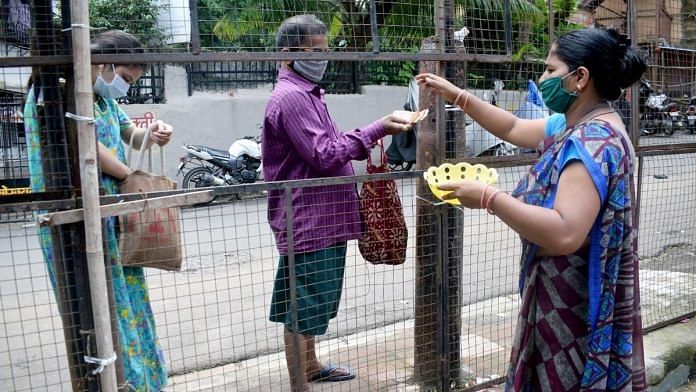Mumbai: With the second wave of the Covid-19 pandemic having hit Mumbai’s non-slum areas more strongly than its dense slums, the number of buildings that the civic body has sealed in the city has nearly doubled in the past one month.
According to data from the Brihanmumbai Municipal Corporation (BMC), as of Wednesday, the civic body has sealed 1,114 buildings in Mumbai, up from 569 exactly a month ago on 28 March. This means, 6.46 lakh of Mumbai’s population belonging to 1.6 lakh households is living inside micro containment zones.
The surge in the number of sealed buildings was accompanied by a spurt in active Covid cases in the city from 45,140 on 28 March to 65,589 as of Wednesday. Mumbai has so far recorded 6,40,507 Covid positive cases and 12,990 deaths.
Every housing society with more than five cases is considered to be a micro containment zone and the civic body seals the premises. Visitors are not allowed in these buildings and the society or building management is in charge of strictly controlling ingress and egress.
If there are less than five cases in housing societies, the BMC just seals the floor. As of Wednesday, there are 10,744 floors sealed in different parts of the city, impacting 15.07 lakh people living in 4.39 lakh households.
In comparison, there are 120 slums and chawls in active containment zones.
Civic officials, however, said there have been signs of the spread abating in Mumbai’s non-slum areas, thanks to the lockdown.
Over the past five days, the number of active sealed buildings has marginally dropped from 1,211 on 23 April to 1,114 on 28 April as new cases in Mumbai have dipped to under 5,000 from between 7,000 and 8,000 until last week.
Vinayak Vispute, assistant municipal commissioner of Mumbai’s H ward, which includes western suburbs such as Bandra, Khar and Santacruz, told ThePrint, “The lockdown has compelled those living in buildings to follow Covid protocol, due to which the situation has improved over the past few days. On a daily basis, the number of new cases from buildings in the ward has dropped nearly 50 percent from just a few days ago.”
Also read: Param Bir Singh moves Bombay HC challenging preliminary enquiry order by Maharashtra govt
‘Home quarantine not strictly followed’
Civic officials monitoring the situation at the ward level told ThePrint that the major reason for there being more cases in Mumbai’s non-slum areas, and a spike in the number of sealed buildings is the concept of home quarantine.
A BMC official posted in an administrative ward where over 79 per cent of the population lives in plush high-rises said, “In slums we are shifting every case to institutional quarantine. So there is no question of that person spreading the infection further. In buildings people stay at home for quarantine. But unfortunately the family keeps in contact with each other.”
He added, “The trend has been, for every positive family member, we have seen the whole household getting infected. Of every one in three cases in buildings, we are finding high-risk contacts also testing positive.”
Another civic official working in one of the city’s upscale suburban wards said in a number of cases, people don’t isolate themselves at home before starting to show strong symptoms.
“This strain is such that symptoms are not evidently visible till the fourth or the fifth day, so for the first few days people carry on as usual and there is a possibility of those around him or her getting infected too,” he added.
Also read: CoWin crash, vaccine shortages cast doubt on 1 May rollout as 18+ register for 3rd phase
Antibodies in slum population
So far, three serological surveys in Mumbai between June 2020 and March 2021 have shown a high seroprevalence in Mumbai slums population. However, every successive survey has shown the seroprevalence in slums declining and rising instead in non-slum areas.
The first serological survey showed 57 per cent of Mumbai slums had antibodies, which develop within one to three weeks of infection. However, their levels start decreasing within a few months of the infection.
The latest serological survey showed 36.3 per cent of the sample size of 10,197 people in Mumbai had antibodies against Covid as against 40.5 per cent in July last year. The survey found a sero positivity of 41.6 per cent in slums, and 28.5 per cent in non-slum areas.
Manish Walunj, assistant municipal commissioner at Mumbai’s L ward, which includes the slum sprawl of Kurla, told ThePrint, “There has been absolutely no change in the behaviour of people in slum areas, but all sero surveys have shown that they seem to have developed a certain resistance. That’s why now, whatever new cases we are seeing they are mostly in non-slum areas, which is the city’s buildings.”
He said, “But, there is a strong likelihood that once the slum population loses its antibodies, and if there is another wave, we could once again see the virus spread through slums like earlier unless we can catch up on vaccinations.”
He, however, added that there is still a lot of vaccine hesitancy in slum areas, leading to a slow pace of vaccination among Mumbai’s slum population.
Also read: If you claim India’s Covid death toll is 2x govt figure, it’s understandable. But not 10x






